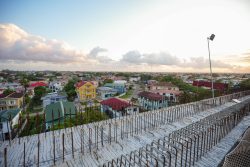Is there any point in the Minister of Finance providing economic forecasts when he is so far off target each year?
For example in his 2022 budget speech, Minister Singh projected that the sugar sector would “grow by 11.8 percent, as GuySuCo will begin to recover from the onslaught of the 2021 floods, with the aim of producing almost 65,000 tonnes of sugar. Similarly, the rice growing subsector is forecasted to expand by 25.1 percent in 2022.”
What actually happened? Sugar declined by 18.9% to 47,000 tonnes while rice was estimated to have grown by 8.1% (although the use of the word estimated suggests some uncertainty over that figure).
Meanwhile in the same 2022 speech, Singh stated that a significant turnaround “is anticipated for the gold mining subsector, which is “projected to grow by 12.2 percent in 2022 on account of higher expected declarations from one large operator, and the small and medium scale miners.”
What actually happened? Singh in 2023: “On the downside, the gold mining industry is estimated to have contracted by 2.5 percent in 2022, stemming from lower output from the small and medium scale producers. Overall declaration of gold fell marginally from 499,054 ounces in 2021 to 486,415 ounces in 2022. The single producing foreign operator recorded a notable increase in declarations, with 101,418 ounces declared in 2022, while output from the small and medium scale operators fell by 10.6 percent to 384,998 ounces, attributed to lower declarations from the top two dealerships.”
So it was only because of the one foreign operator that the fall in declarations was not far lower. Never mind. This year Singh kept up his rosy forecast: “a turnaround is anticipated for the gold mining subsector, which is projected to grow by 12.7 percent in 2023, on account of higher expected declarations from one of the large operators, and the small and medium scale miners.”
This looks very much like a 94-page cut and paste budget speech with the minister simply picking numbers out of thin air for what were once the three key sectors of the economy.
The truth is that 1) gold production is probably doing far better than the declarations suggest because of the rampant smuggling in the sector, and 2)No, GuySuCo will not “become profitable again”, as Minister Mustapha proclaimed. It really should be placed under the Ministry of Human Services and Social Security.
As for the rice sector it is probably in as bad a shape as sugar. Two recent articles in Stabroek News made that very clear. One set in Berbice, the other in Leguan both showing the common problems facing farmers. A visit by Stabroek Business to Black Bush Polder saw many complaining of irregular weather patterns and higher costs of production. Liverpool resident, Hubern Corlette told Stabroek Business, “the cost of applying a bag of manure to an acre of land has ‘jumped’ from $800 to $1300 while the cost of fertilizer too had taken off on an upward trajectory, jumping from $4000 to S11,000 and spraying had increased from $400.00 to $600.00.” Corlette disclosed that he had not planted rice for the previous season.
Several Berbice rice farmers also confirmed that the rice sector in the region is currently faced with an acute labour shortage, including a shortage of tractor operators. These days, labour costs can be as high as around $7,000 per day. The drift away from working as labourers in the rice sector has come…” One would suspect that these heavy-duty operators have migrated to jobs in the oil and construction sectors as part of the frenzied government mandate to build transformational infrastructure.
Over in Leguan, “Veteran rice farmer Mohammed Ramza, who has been involved in the industry for more than six decades, told Stabroek News that because of the current state of the industry, he has scaled down his operation by more than 20 acres within the last three crops. “Rice is done with. It can’t pay. Me had 63 acres but me can’t plant it all because it can’t pay. I had to leave back 20”. Again we heard the familiar complaints about millers not paying a viable price and paying late. Ramzan explained that it costs roughly more than $50,000 to prepare an acre of land, including the cost to plant the rice, but they only earn about $40,000 on their investment, which is a loss.
“So there you have it. On every acre you are going to get at least 20 bags of paddy and the millers are offering us around $1,800 to $2,100 per bag. So, let’s say we use $2,000 per bag, then you’re only going to get about $40,000 for that one acre that you spent more than $50,000 on.”
In both areas, unreliable weather patterns in recent years have seen many farmers hesitating to plant two crops. And while farmers complain about lower prices, millers are also grappling with higher costs especially for transportation. They are being squeezed in export markets such as Europe where cheaper producers are increasingly taking market share. In other words with increased costs the rice industry is struggling to be globally competitive.
This is how the rampant increases in the cost of living and doing business that are at the heart of this country’s current economic quandary, are dealing a blow to our exports. Dutch disease is already here even as the President insists on overheating the economy even more. This flies in the face of the IMF report which warned in June that “a large surge in public investment could add inflationary pressure” and “affect competitiveness of the non-oil economy.” This is bottomhouse economics.
Behind the headlines and the rosy forecasts, rural Guyana remains impoverished and increasingly abandoned with the cost of living making it harder each day for families to feed themselves. Cabinet ministers in the budget debate rebutted the populist view about increasing salaries and social safety nets, preferring to point out all the other areas they were assisting people to have more purchasing power.
It’s not working and perhaps that’s why Minister Singh didn’t announce one statistic buried in the appendices: a migration rate in 2022 of 16.6 per 1000 citizens, among the top ten in the world.





